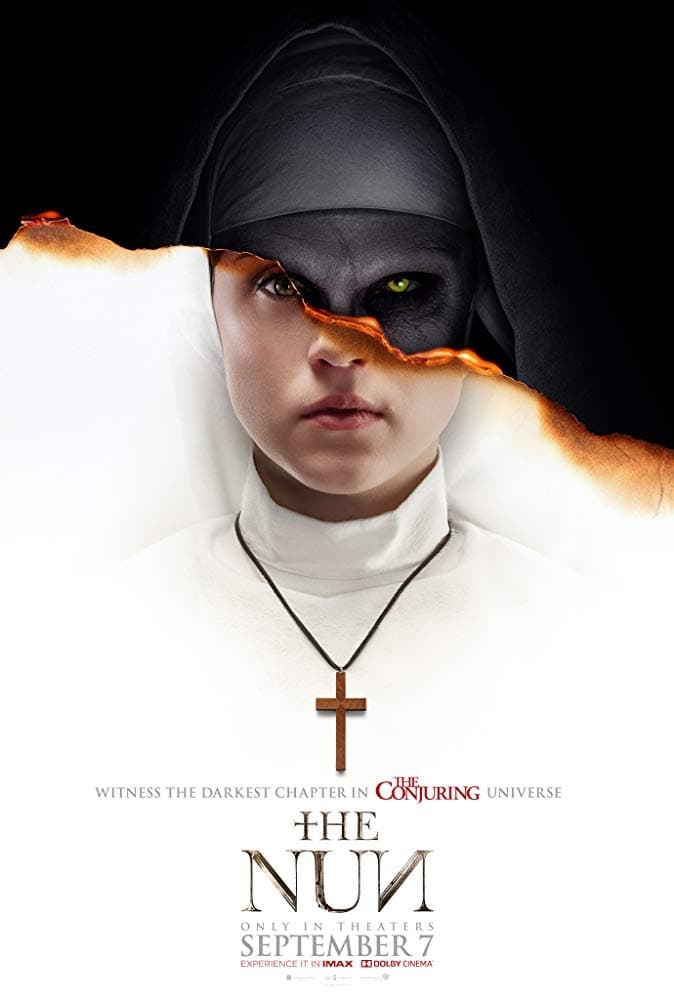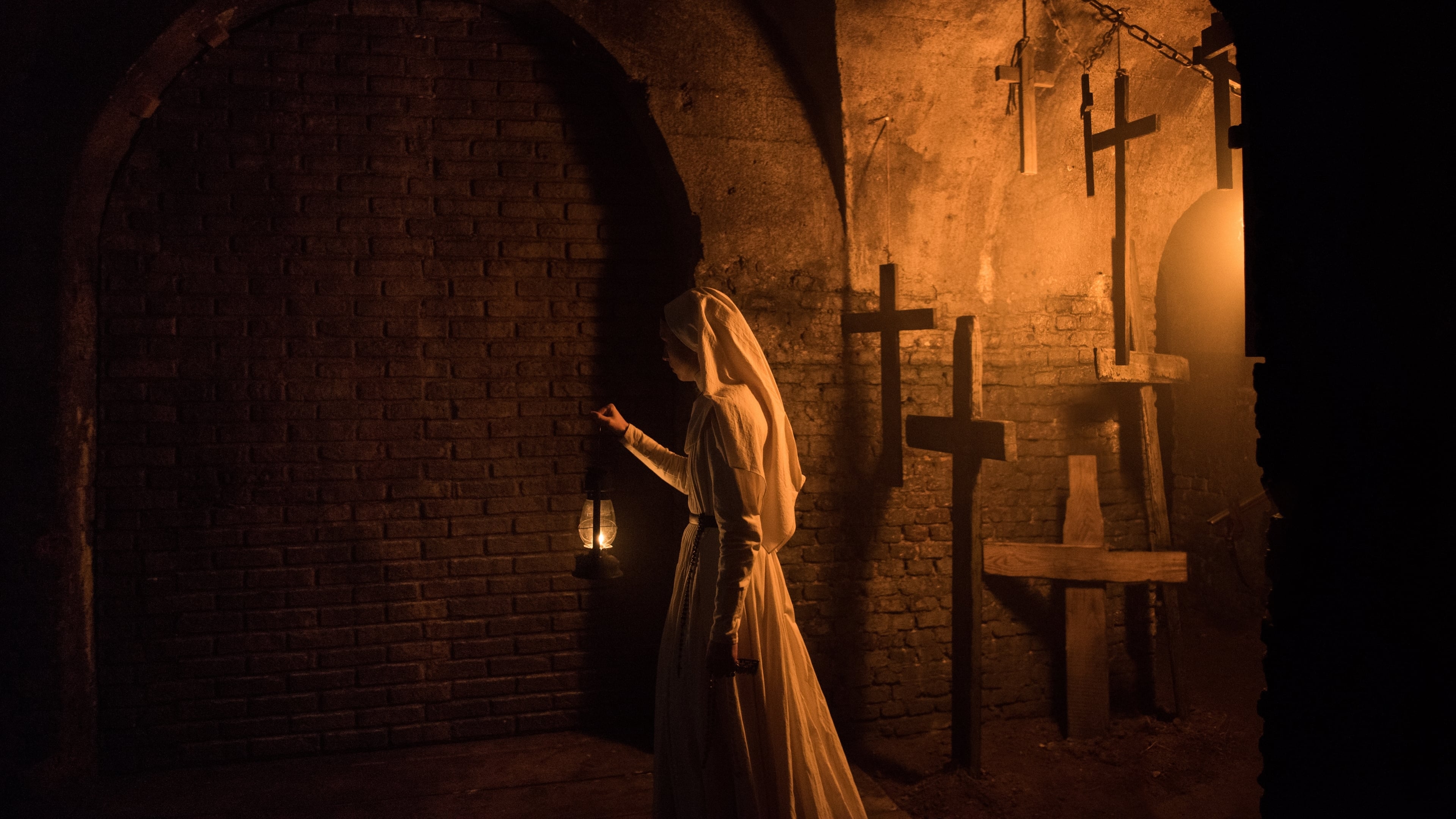
Nun more black
"The blood of Christ."Rigorous honesty compels me to admit that the new horror picture The Nun is not actively good, and may in fact even be bad. At least, it has terrible dialogue and hugely contrived scare scenes. But I find myself subjecting it to the rules of a game that I made up when I was about one-third of the way through the film's 96-minute running time: a game called How Would I Feel About This If It Was In Italian? And I have to say, I think I'd feel pretty fucking good.* Not least because there kind of already has been a version of The Nun in Italian: it's called The Church, it's by the deeply undervalued director Michele Soavi, and it is gaudy, weird, and wonderful. I am surely not being so reckless as to say that The Nun is as good as The Church, but it's starting in the same place and facing in a similar direction.
"Holy shit!"
"The holiest."
-An actual exchange of dialogue written by an actual professional screenwriter for an actual movie
That place being a huge old pile of a religious building sitting right atop a hellmouth, and that direction being, "let's dump absolutely everything on the viewer, and let's do it the whole time". The film's story is barely even a smudge of a scenario: in 1952, Father Burke (Demián Bichir), one of the Vatican's "miracle hunters", is tasked to find out what's going on at an extremely remote convent in Romania (seeing a cheap American genre picture shot in Romania that actually allows its host nation to play itself is, in some odd way, my favorite single thing about the movie), where a nun has just hung herself. We know a little something more than Burke does, because we saw that nun and one of her fellow sisters sacrifice themselves rather than be taken by a shadowy, human-shaped figure in the darkness. We also know that we're watching a movie called The Nun, and we know from the film's unfathomably artless opening scene that this is a spin-off of the 2016 film The Conjuring 2, which is chunkily recapped in what feels very much like the "previously on..." reel that kicks off an episode of a TV police procedural. So we can guess that the titular nun is the nun-shaped demon played by Bonnie Aarons in that film and a wee tiny cameo in 2017's Annabelle: Creation, and it certainly is so.
Anyway, Burke goes to Romania with a very nervous novitiate, Sister Irene (Taissa Farmiga, 21-years-younger sister of The Conjuring and The Conjuring 2 star Vera Farmiga, whom she significantly resembles; if this is meant to pay off in some way other than as an inside joke, it will have to wait for the almost certainly inevitable Nun 2). There they meet a cowardly lothario nicknamed Frenchie (Jonas Bloquet), whom the film takes great pains to explain is not French, he is French-Canadian, and also to specify the reason he's in rural Romania, and given that every actor in the film is speaking English with their native accent, I really don't see why the bother, but I guess it's nice that screenwriter Gary Dauberman (who co-wrote the story with franchise guardian angel James Wan) cares about specificity. So the three of the them traipse through the oppressive woods to the convent, a gigantic monstrosity housed in a massive, rotting castle that's the worse the wear from bombing in the recently-completed war (it's played from the outside, splendidly, by Hunyadi Castle, one of the truly great among the European castles). Here, they discover that everything is completely fucked up.
There are three very important things that The Nun isn't, but seems to suppose it might be: 1) scary; 2) a character study; 3) intelligible. To point 2), we learn quite a bit about Burke and Irene - the former had one of those Failed Movie Exorcisms that resulted in the death of a young boy, and you had best believe that the fucked-upedness in the nunnery is going to choose to manifest as that boy, with a tendency to puke venomous snakes - but it's all pretty boilerplate and trite, certainly far too much so to support any sort of reading of The Nun as a decent study of faith in crisis, as was very much true of The Conjuring 2 and even popped up a little bit in Annabelle: Creation.
To point 1), the blunt fact is that all of these Atomic Monster productions set around the assortment of demons that have made life rough for (the, by now, entirely fictitious character being called) Lorraine Warren follow a pretty clear, repetitive formula in how they build their scares. If a composition shows a large chunk of negative space behind a character, and the camera pans to left or right, you can bet your bottom dollar that when it pans back to the character, Something Dreadful will be standing behind them. If somebody is stealthily walking through a dark space and the image is either over their shoulder or in a direct POV shot, there will be a sudden appearance of a pale-faced ghost with large teeth and discolored eyes approximately 1.5 seconds after you expect there will be. The musical score never lies, and when it starts to rise in volume while shedding tunefulness, you're moments away from an apparition (that being said, I actually rather admire Abel Korzeniowski's score for The Nun: within the framework he has been given to operate, he's come up with some fairly moody, evocative cues). I find, to be charitable to The Nun, that it works as long as you decide in advance that it will work; one can elect to be knowing and sophisticated and thus find it miserable, or one can be there to have fun, and I spent many fun minutes with my hands dancing around my face and eyes as The Nun did precisely the things I expected it to do in precisely the order I expected them. I once received a piece of advice for reading H.P. Lovecraft: since he finds literally everything in the world terrifying, you'll get the most out his stories if, for the duration of 10 pages, you make a contract with the book that yes, you'll agree that, like, ornate doorknobs are so repulsive that your eyes can barely perceive their shape. And I think I'm coming around to the same thing with the Conjuringverse movies.
Anyway, back to my list, and point 3). This is a baffling movie, with its three main characters running around the woods and in the decaying stone halls of the convent like the Scooby-Doo cast, and while is generally easy to parse it at the level of the individual scene, all the scenes together feel like a fever dream of sorts, just a whole bunch of creepy stuff packed into one vaguely three-act structure. I find this beguiling. What The Nun has, and this is why it feels so very Italianate to me, is a kind of mesmerising flow of irrationality, a very dreamy momentum of constant activity, all of it bad. There is one major plot event that reads exactly like a dream sequence: Burke thinks he sees the dead boy from his exorcism, follows him into a graveyard, is pushed backwards into an open grave, and when he lands in the coffin, the grave has already been covered in dirt for many long years. Except this actually happens in the story. That's an extreme example, but the way The Nun completely eradicates our ability to sensibly codify what happens as real or not, hallucination or not, dream or not, is one of its great charms to me. It's an assault, pure and simple: an assault on the characters' sense of meaning and thus against ours.
The other big charm is that the film is madly in love with the idea of old-school matinee movie horror. Director Corin Hardy's other feature, 2015's The Hallow, is basically just a spooky campfire story about the spooky pleasures of supposing that God knows what lives in the gloomy woods, and in some respects, The Nun is just that ethos with more of a budget. This is a shamelessly atmospheric film, trying to capture everything magical about old Gothic horrors like the Universal monster movies where there are huge full moons hanging over ridiculously overdone cemetery sets (and there is one here - not a single one of its countless crosses is straight up, and they're all surrounded by a practically luminescent, shin-deep fog), or the Hammer movies that find big stone buildings suitably moody regardless of how they're lit (too brightly, in Hammer's case; too dim, here), or whatever the hell happens inside them. None of this is presented with a trace of irony or any sense of humor, so we can't call it camp; it's more like Hardy and his crew just really wanted to indulge a love of over-the-top haunted house imagery for the sake of it. Clearly, this kind of unstinting kitsch isn't to all tastes, but the crisp autumnal chill coming off of The Nun is more or less exactly what I want out of a schlocky September horror movie.
Reviews in this series
The Conjuring (Wan, 2013)
Annabelle (Leonetti, 2014)
The Conjuring 2 (Wan, 2016)
Annabelle: Creation (Sandberg, 2017)
The Nun (Hardy, 2018)
The Curse of La Llorona (Chaves, 2019)
Annabelle Comes Home (Dauberman, 2019)
The Conjuring: The Devil Made Me Do It (Chaves, 2021)
The Nun II (Chaves, 2023)
*I can already tell that this is going to be the kind of horror review where I feel duty-bound to discredit myself right off the bat and get it out of the way by reminding you all that I am, as far as I know, the only living human who thinks that The Lords of Salem is the best English-language horror film of the 2010s.
Categories: horror, scary ghosties, spooky old buildings, worthy spinoffs






